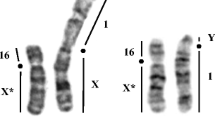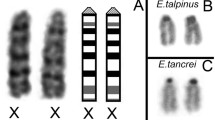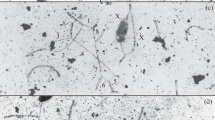Summary
Genetic studies on Searle'S X-autosome translocation of Mus musculus have shown that a segment of the X carrying the loci for two sex-linked genes, Ta and Blo, has been translocated to an autosome. Females heterozygous for Tabby normally have variegated hair structures, with transverse Ta bands visible against a background of wildtype fur. When the wild-type allele of Ta or Ta itself was located on the translocated X, it was capable of full expression in heterozygous females. Thus, the Tx+/+Ta genotype was completely wild-type, while TxTa/++ genotype showed the phenotype of the Ta hemizygote (Searle 1962; Lyon, Searle, Ford, and Ohno 1964).
The present study on meiotic figures of the male carrying this translocation revealed that the reciprocal translocation was one-sided in favor of the autosome. While the at became nearly twice the size of the original autosome, the Xt became almost half the size of the Xn. The study of somatic prophase figures of the female carrying this translocation further showed that the Xn manifested positive heteropycnosis in 90 per cent of the cells. Thus, genes on the normal X should be inactivated in most somatic cells of the female, allowing full expression to the genes on the translocated X.
Similar content being viewed by others
References
Bauer, H.: Der Aufbau der Chromosomen aus den Speicheldrüsen von Chironomus thummi Kiefer. Z. Zellforsch. 23, 280–313 (1935); - Beiträge zur verglei- chenden Morphologie der Speicheldrüsenchromosomen. Zool. Jb., Abt. allg. Zool. u. Physiol. 56, 239–276 (1936).
Beermann, W.: Ein Balbiani-Ring als Locus einer Speicheldrüsenmutation. Chromosoma (Berl.) 12, 1–25 (1961).
Cattanach, B. M.: A chemically-induced variegated-type position effect in the mouse. Z. Vererbungsl. 92, 165–182 (1961).
Levan, A., T. C. Hsu, and H. F. Stich: The idiogram of the mouse. Hereditas (Lund) 48, 676–687 (1962).
Lyon, Mary F.: Gene action in the X-chromosome of the mouse (Mus musculus L.). Nature (Lond.) 190, 372–373 (1961).
-, A. G. Searle, C. Ford, and S. Ohno: A mouse translocation suppressing sexlinked variegation. Cytogenetics (in press).
Ohno, S., and B. M. Cattanach: Cytological study of X-autosome translocation in Mus musculus. Cytogenetics 1, 129–140 (1962).
Ohno, S., T. S. Hauschka: Allocycly of the X-chromosomes in tumors and normal tissues. Cancer Res. 20, 541–545 (1960).
—, W. D. Kaplan, and R. Kinosita: Heterochromatic regions and nuoleolus organizers in chromosomes of the mouse, Mus musculus. Exp. Cell Res. 13, 358–364 (1957).
Russell, L. B.: Mammalian X-chromosome action: inactivation limited in spread and in region of origin. Science 140, 976–978 (1963).
—, J. W. Bangham: Variegated-type position effects in the mouse. Genetics 44, 532 (1959).
—, C. L. Saylors: Factors causing a high frequency of mice having the XO sex-chromosome constitution. Science 131, 1321–1322 (1960).
Searle, A. G.: Is sex-linked Tabby really recessive in the mouse? Heredity 17, 297 (1962).
Author information
Authors and Affiliations
Additional information
With a great sense of honor, we contribute this paper to the special issue of Chromosoma dedicated to Professor Hans Bauer on the occasion of his sixtieth birthday.
Contribution No. 30–64, Department of Biology, City of Hope Medical Center. This work was supported in part by grant CA-05138-05 from the National Cancer Institute, U.S. Public Health Service.
This study provides a cytological foundation for the previouslydescribed genetic findings on Searle'S X-autosome translocation in the mouse.
Rights and permissions
About this article
Cite this article
Ohno, S., Lyon, M.F. Cytological study of Searle's X-autosome translocation in Mus musculus. Chromosoma 16, 90–100 (1965). https://doi.org/10.1007/BF00320564
Received:
Issue Date:
DOI: https://doi.org/10.1007/BF00320564




